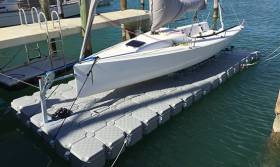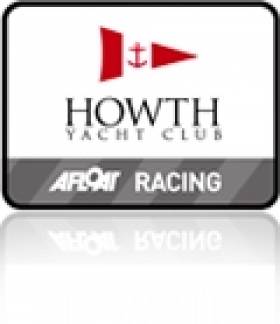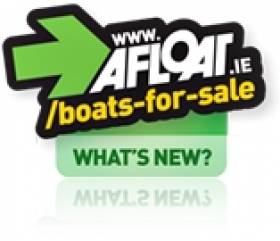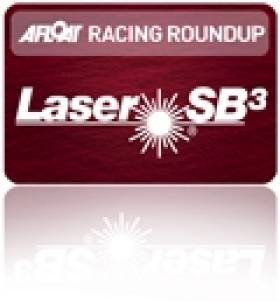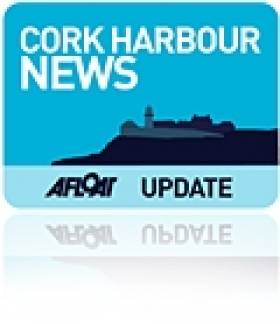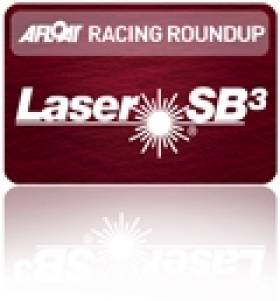Displaying items by tag: Sportsboat
Lift out on to hard standing is the ideal way to keep a sportsboat clean but has the added burden of lift in and out each time you want to sail. VersaDock, the modular floats provider for pontoons and dock solutions, has introduced its latest dry dock to give sportsboat and other small sailing boat owners the benefits of low maintenance and convenience of berthing their boats clear of the water.
The latest generation Version 2 of the VersaDock DrySail™ System (V2) has been designed and engineered specifically for modern lifting keel sports boats. New technology and design has enabled the DrySail™ V2 to be extremely light and very easy to assemble.
Drysail ™V2 is sold as an alternative to marina drysailing contracts, or being in the water for lond periods. It’s easy to winch your own boat in and out of the water in around a minute at any time. The stable platform gives handy all round access to the boat.
Drysail ™V2 is less than half the weight of previous generations of drysail docks, and its frames are smaller and easier to pack, which claims Versadock means there are huge savings to freight costs to any part of the world. Best of all, the new design is so simple to assemble that you can do it yourself, saving on installation charges.
The DrySail™ V2 system works in conjunction with all other VersaDock systems and can be integrated into their standard pontoons, platforms, drive on docks and walkways. The standard dock fits into a normal sized marina berth, turning it into a drysail platform, and it can be moored alongside other pontoons, or secured to river moorings. In fact its versatility means it can be put virtually anywhere where a boat can float onto it. It can even sit securely on the bottom if the tide dries out.
VersaDock has designed the new DrySail™ V2 dock for the J/70, Melges 24, SB20 and Longtze Premier, to name a few types of sportsboats, while the system can easily be optimised to fit individual requirements.
VersaDock are offering Drysail ™V2 at an introductory price of £6100 ex. tax and delivery for a typical J/70 dock until 1st July.
Dublin Bay Sailing Club Announces New Mixed Sportsboat Class
Dublin Bay Sailing Club has taken the decision to support the formation of a mixed sportsboat class to join the twenty other classes racing under the Club’s burgee in Dublin Bay. The decision follows a meeting of the Bay's sportsboats interests earlier this month.
The class will race every Saturday on primarily windward leeward courses, with committee boat starts, throughout the 2016 season. Also racing on this course will be the SB20, Flying Fifteen and Dragon fleets. Racing will also be provided for the new class on DBSC’s midweek courses on Thursday and Tuesday evenings.
The mixed sportsboat class will consist of 1720s, J80s, J70s, Melges 24, Bachman 21s and similar such craft.
There was a wide variety of opinion at the recent meeting at the Royal Irish Yacht Club.
With such a disparate range of views it is not easy to put together a cohesive summary of what was said. Here are the major themes that emerged:
- There exists a certain cohort of potential DBSC sailors not being catered for within the existing class structure.
- These would be people not interested in the traditional DBSC keel boat, favouring instead a less expensive smaller, lighter, more venturesome model.
- Abroad, all new production boats are of the asymmetric variety. DBSC will have to move with this new world. Sailors coming through the junior sections all look to race in this new type of craft.
- Some concern that the mixed sports boat class might adversely affect the existing SB20 class – a view that effort should be directed instead to driving forward the SB20s.
- Repeated assurances that DBSC will continue to support the SB20s.
- Demand for the new class must come from the membership or potential new members. Obviously DBSC is concerned to arrest the decline of income and entries and must find revenue streams to support its race management superstructure.
- The nucleus of the new class would come from the existing stock of 1720s in the waterfront clubs and in private possession. They are of varying configurations and sail condition and could not be rated as one-design. An Echo-type results system would be required.
- Finally, an acceptance that the mixed sportboat model is the way to go and a many expressions of goodwill towards DBSC in its efforts to find the way forward.
Dublin Bay Sailing Club (DBSC) Discuss Mixed Sportsboat Class
Providing a mixed sportsboats class in Dublin Bay Sailing Club next year would not only cater for a range of boats currently based in Dun Laoghaire but also foster and encourage new buyers to source “fun”, affordable day racers writes Olivier Proveur, the Sailing Manager of the National Yacht Club who has prepared a discussion paper on the 'Reinstatement of a sportsboat class by DBSC'.
Is it time for DBSC to introduce a new mixed Sportboat Class in its racing programme? What is a sportboat? How much would it cost to enter one in DBSC? When will they be racing? Which handicapping system will be used? To discuss all these issues, an open meeting will be held by DBSC in the Royal Irish Yacht Club next Thursday 3rd December at 20.00
Reinstatement of a sportsboat class by D.B.S.C – Discussion document
Purpose
The purpose of this document is to help explore the possibility and modalities of introducing a “mixed” sportsboat class (or classes!) in DBSC Club racing from 2016 onwards.
The document covers:
- The definition of “Sportsboat”
- Various arguments for providing a racing prospect to a mixture of sportsboats
- The further refinement between “high performance” and “low performance” sporstboats
- Resulting considerations on handicaps and classes
- A broad but non comprehensive view of “the world of sportsboats”
Definition
The term sportsboat first appeared in the late 1980s and early 1990s to describe high performance trailer yachts with major compromises in accommodation and weight compared to traditional designs of the same size. They tend to be characterised by historically large sail areas for a given length (especially under downwind sails), light weight construction and a heavy reliance on crew weight to counterbalance heeling forces. They usually feature lifting keels (for easy trailerability) of a modern fin and bulb design and planing hull designs. Most sportsboats are self-righting as opposed to skiffs.
Sportboats are generally characterised by a tall mast for their hull length, a correspondingly large main
sail and non-overlapping jib. As with the large mainsails, spinnakers (asymmetric in the vast majority of designs) are also generally much larger for a given hull size than had previously been used for keelboats, including racers.
Sportboat hulls have many elements in common with skiffs such as an almost flat bottom, a fine bow and a flat aft section - in short, a planing hull form.
This very efficient, low-drag shape, combined with the large, powerful rig and sail design and the light weight construction of most sports boats is what gives them their significant speed advantage over traditional designs.
To offset the large sail area and the resulting significant heeling momentum there are 3 main design philosophies:
- a deep and heavy keel;
- a way to get the crew further off the centreline by using wings, racks, hiking aids or trapezes; and,
- a reduction in sail area, leading to a reduction in displacement, leading to less need for sail area and thus a reduction in heeling momentum.
Many modern sportsboats use some combination of 1&2 or 2&3 also, with option 1 tending to favour upwind legs, and option 3 tending to favour downwind; option 2 being an advantage in all respects
except rating.
Most sports boats use the modern fin and bulb design, which may also be lifting for ease of storage, as most sportsboats are designed to be taken out of the water on a daily or regular basis.
Most sportsboats have no or very little on-board accommodation as they are primarily intended to be sailed in short races around laid courses on sheltered waters. They are intended only for use in races for limited durations. A typical club sportboat race would be between 2 and 3 hours long and the biggest regattas would usually feature 3-4 races a day, each of only 1 to 1.5 hours duration.
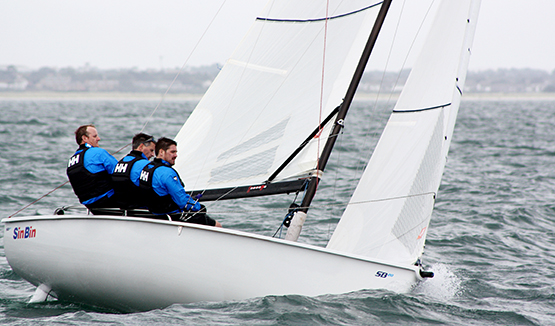
SB20 – Photo: Michael Keogh
Cockpits are usually fully open and the only covered area is a very small and spartan fore-cabin (cuddy), usually used only for storing sails and essential safety equipment. Even larger sports yachts which often do have a proper cabin below are often missing all the usual features of a yacht. Sinks, toilets, bunks, water tanks and cooking equipment are usually missing. Often a moulded hard plastic seat on either side of the cuddy and a removable chemical toilet are the only amenities.
In summary:
From the defining characteristics of “what is a sportsboat”, a few self-evidences emerge:
- They are ideally suited to take part in the type of racing organised by DBSC
- They are far removed in terms of design and sailing characteristics from the “traditional” keelboats designs which the IRC Rating System is ideally suited to “regulate and time compensate” in mixed fleets- Though broadly fitting the design principles above, they hugely vary in terms of LOA, performance, built materials etc etc…(see the “world of sportsboats”).
- All sportsboats are conceived, designed and marketed as “one-designs” though, to the notable exception of the Cork 1720 and SB3 in the past, it is difficult to see the establishment of a new Sportsboat one-design class in Ireland and furthermore in Dublin Bay alone. The latest example being the initial “hype” around the J70 when it was launched which only translated in 1 being purchased and campaigned…
- Why is DBSC considering a mixed sportsboat class?
- There is now a good number of non SB20 sportsboats based in Dun Laoghaire; privately owned J80s & J70s,
Clubs’ 1720s, others...
- There is maybe also a renewed interest among “younger” waterfront Clubs’ members to acquire a keelboat and go racing in DBSC…
- However, gone are the boom times when a string of J109s appeared in Dublin Bay…would be competitors are looking at a maximum capital outlay of €15k to €20k for “something exciting”…
- Due to their lack of unnecessary (for day racing) equipment (costly inboard engines, fridges, showers etc…) and
lack of accommodation, second-hand sportsboats offer great value for money compared to “affordable” cruiser racers.
Below are 2 boats for sales ads (besides each other) from apolloduck.co.uk under the category “racing
boat”: Hunter 707 - £4,750 CORBY 25 - £37,500
The first one (Hunter 707) having not been conceived and designed as a “cruiser-racer” has either no “cruiser” class to comply with and compete in or would not be competitive at all under IRC rating.
The 2nd one (Corby 25) would be of interest to anyone wishing to have a go at the Cruiser II class…however it is 7.9 times the price!!! (Are they THAT different? Is it 7.9 times the boat?!?).
- The only possibility currently to race a sportsboat (other than SB20) in Dublin Bay is to enter a 1720 in the Ensign Class on Tuesday evening…
- Providing a mixed sportsboats class in DBSC next year would not only cater for the existing boats (SB20 & 1720s in the main) but also foster and encourage new buyers to source “fun” affordable day racers (see the world of sportsboats)
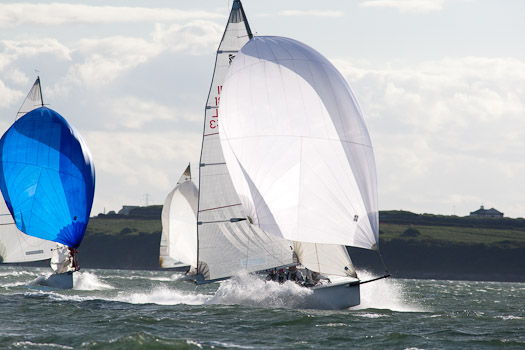
Ireland's own sportsboat – the 1720 . Photo: Bob Bateman
How to cater for a huge potential diversity of sportsboats in a “sporting fair way”?
There is a huge difference in LOA, sail area and design between various sportboats. Can they be mixed in the same class, on the same start?
Introducing clear, non-arbitrary definitions and “class rules” is paramount to gain traction and acceptance from all parties.
To this end, a very interesting case scenario exists in the UK:
The Forth Yacht Clubs Association (FYCA), the forum for clubs on both sides of the Firth, came to the
following solution when faced by a similar issue:
As seen before, Sportsboats are lightweight planing yacht designs that have distinctly different performance characteristics compared to conventional displacement yachts. If race conditions permit hydrodynamic planning then standard handicap values, that are mainly based on displacement performance, are not representative.
Yachts with RORC Sportsboat Ratings (SBR)1 range from those that plane readily such as the Melges 24, Cork 1720 and Laser SB3, to more conventional designs that do so only rarely.
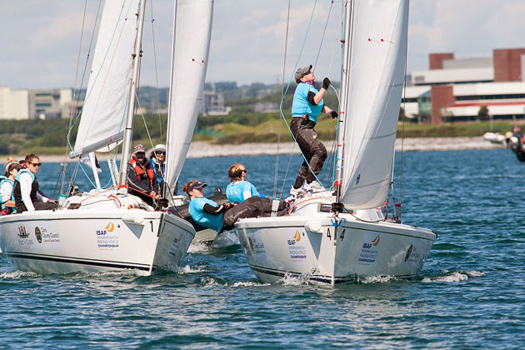
The J80. Photo: Bob Bateman
FYCA clubs organising separate classes for sportsboats and displacement yachts, to promote better and fairer competition whatever the wind and sea conditions, required a sportsboat definition to differentiate between ‘high performance’ and more conventional sportsboats. The FYCA Handicap Committee proposed a sportsboat definition based on design analysis rather than arbitrary classification.
After consultation with Mike Urwin, Technical Director of the RORC Rating Office that provides IRC and SBR certification, the following ‘high performance’ sportsboat definition was recommended:
• Downwind power to weight ratio >= 0.50
(SA/D^0.67 based on total downwind sail area m^2 [Main+Spin] divided by total displacement Kg^0.67 [Including crew weight])
• Displacement to length ratio <= 170
(DLR = (27.87 x IRC Displacement)/LWP^3 as defined by RORC measurement rules)
1 More on rating system below
The table below details the analysis of sportsboat designs compared to conventional displacement
yachts.
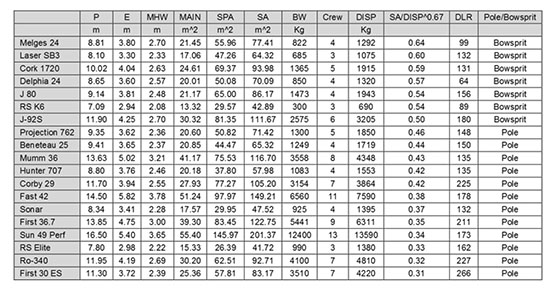
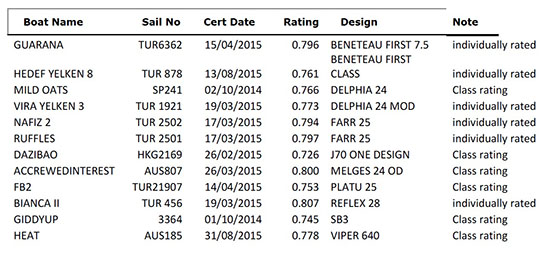
In turn, using Mike Urwin definition of high / low performance sportsboat, it is possible to plot the following
graph:
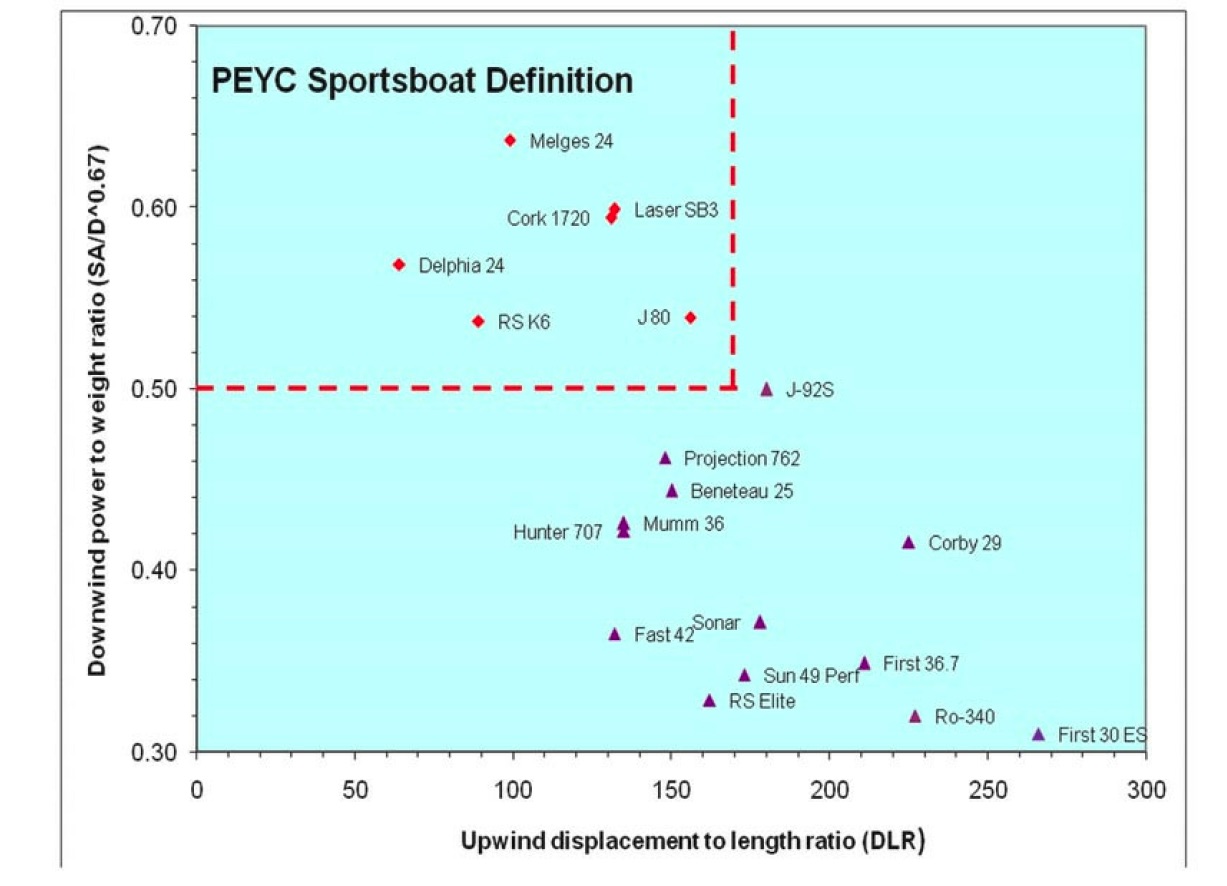
“Plotting” boats show categorically that, in fact, SB3s and Cork 1720s are extremely close in their designed performance! Maybe the fact that both boats were designed by Tony Castro is no coincidence?
Also, it is made much clearer that:
The following SBR rated designs are classified as ‘high performance’ sportsboats:
• Melges 24
• Cork 1720
• Laser SB3
• Delphia 24
• RS-K6
• J-80
The following SBR rated designs are not classified as ‘high performance’ sportsboats:
• Projection 762
• Beneteau 25
• Hunter 707
• RS Elite
• Sonar
In conclusion to these considerations:
- The existing “sportsboats” based in Dun Laoghaire naturally form a “homogenous” (by designed performance) group which, following Mike Urwin’s classification, could be amalgamated in a new “High Performance Mixed Sportsboats Class”
- There is also potentially room to create a “Low Performance Mixed Sportsboats Class” to foster the acquisition by “new comers to DBSC” of great value for money and great sailing boats such as Hunter 707s, Beneteau 25s (=Farr Platu 25), Projection 762s and, speaking from my own experience, Brenta 24s and 747 ODs
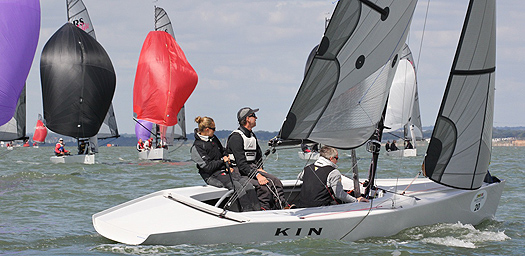
RS Elite
OK, but which handicap system?
Sportsboats at first raced in existing class divisions under existing handicapping systems. As the number of sportsboats continued to grow specific divisions for them have become increasingly common at all levels of racing.
In Europe and the USA, the trend has been more for One Design racing.
Sportsboat-specific handicapping systems include:
- RYA/RORC Rating: Sportsboat rule SBR
- Individual country rule systems such as the New Zealand Sportsboat box rule and Australian SMS system.
SBR:
The RYA/RORC Sportsboat Rule (SBR) was introduced in 1996 as a joint venture between the RYA and the RORC. The numbers of individual boats rated each year have fluctuated largely as a result of popular classes using the rule prior to becoming Recognised One Designs with the highest number rated in any one year being around 250.
Over the successive years, the number of individual boats rated has fallen to just 48 in 2009, therefore the RYA and the RORC have taken the decision that SBR will be discontinued with effect from 1st January 2011 (1st June 2011 in Southern hemisphere countries)
In 2004 and 2010, Cork Week had a mix sportsboat fleet with results calculated using SBR rating certificates. Both the RYA and the RORC were however concerned that the sportsboat fleets should continue to be able to race. To ensure this the RYA promoted and establish Portsmouth numbers for as a few standard sportsboat designs:
Below is a table of compiled of “older” PY ratings found and compiled on an “ad-hoc” basis: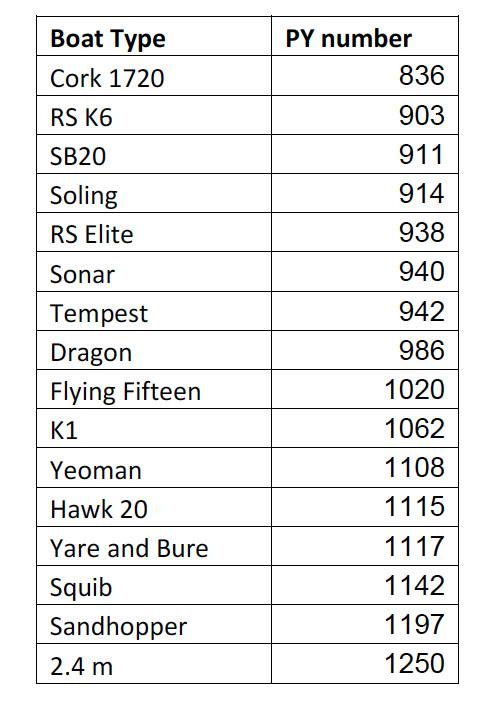
However, only a few are officially listed as a class with a maintained PY handicap on the RYA website for 2015 here

In conclusion, for the purpose of producing fair results in a mix-sportboat class (or classes) in a Irish / Dublin context, we can neither use the defunct SBR (based on boat measurement) system nor its PY “successor” based on results averages in club races in the UK.
We need to look further afield in racing “jurisdictions” where sportsboats are numerous, varied in design and regularly raced. The Australian SMS system (http://www.raceyachts.org/)
The Sportsboat Measurement System (SMS) was introduced in 2008 and during the years has grown substantially. It is now being adopted in a number of other countries and includes many different classes that fit the definitions of a sportsboat.
For example, in Turkey, an active fleet has been established at Kalamış Sailing Club and Sukru Sanus has
measured an inaugural fleet under the SMS system.
The Australian SMS system is also in use in Hong Kong; The sportsboat fleet in Hong Kong voted to adopt SMS and has measured Magic 25's under SMS as a One Design fleet (ie once a boat is rated, all other boats compliant with the particular sportsboat class measurements can use the same rating – see rated boats below)
With new technology and innovative designs, it is impossible to remove all of the inequities on a permanent basis, so the SMS rating formula is updated on a 4 year cycle in line with the issue of each new Racing Rules of Sailing (so updated in 2012, next update in 2016) to accommodate modern designs.
Pricing is also very reasonable. The fee structure was as below for 2015: AUS$ €
Initial Certificate $75.00 €47
Review of Rating $65.00 €41
Revalidated Certificate $65.00 €41
Amended Certificate $65.00 €41
Copies of Certificates $40.00 €25
Test Certificate $40.00 €25
Change of boat name/owner $35.00 €22
SMS system – empirical assessment
The SMS system was first used at the 2008 Meridien Marinas Airlie Beach Race Week, pictured below.
The event had been the test track for new design concepts in this rapidly expanding and exciting class of yacht racing , giving race officials a problem in equating a fleet that ranged from Elliot 7s through to the hitech Stealth 8s and a one-off sports boat designs
With the exception of one boat - the smallest and least expensive in the fleet - corrected time results under SMS have been 'quite equitable' across the fleet, resulting in generally close handicap results, according to Australian Sport Boats Association (ASBA) secretary Cam Rae.
'We are very pleased with SMS,' Rae said. 'If you look at the results in each race to date you will see close results on corrected time. In race one the top nine boats were less than four minutes apart. In that race we saw two of the fastest and most expensive boats, Vivace, an original Bethwaite 8, and Conquistador, a new sports 8 xx, split by Quantum Sailing, an Egan 6, and probably the least expensive boat in the fleet.'
Boats rated under SMS
There are currently 117 sportsboats rated under the Australian scheme. Some avail of a “Recognised One Design” handicap (ie all boats compliant with their OD class measurements use the same handicap), some have been measured individually as either once off or modified from their original one design measurements.
Below is a sample of European boat types rated;

Conclusion on Sportsboats rating system considerations:
The Australian SMS is available for DBSC to use as an affordable, well documented, user friendly and up–to–date, sportsboat specific handicapping system.
It is also notable that the freeware and well known result calculating software “Sailwave” natively support calculating results under the Australian AMS handicap system (and by extension the SMS one by simply inputting the SMS values for each boat in the rating field of the series file)…for an example of such results, please click here
Key recommendations for consideration by DBSC
This document advocates:
- The creation of a mixed-sportboat class
- The use Australian SMS rating system and Sailwave for results if unsupported by YR3
- Eventually / potentially, depending on numbers, the creation of a “high performance”
sportboat class and a “low performance” sportsboat class using Mike Urwin defintions or a
SMS Rating band in line with the IRC bands used by DBSC.
Notes:
- There is no equivalent of “endorsed certificates” in the SMS system
- For practical, speed of introduction of the rating system and to limit the costs to owners, it is
therefore possible to:
o Allocate an already existing SMS rating for previously measured one design boats
(J70 etc)
o Measure 1 boat representative of a group of boats (thinking of the modified 1720s in
use by the RIYC, RSGYC and NYC) and allocate the same SMS rating to all
o “fine” tune rating for individual boats at the request of individual owners…
The world of sportsboats
I have compiled a non exhaustive online database of common sports boats and their characteristics here
Document prepared by Olivier Prouveur
Sailing Manager
National Yacht Club
SB20 Class Ditches Outboard Engine In Favour of Paddles, Crew Weight Limit Also Goes Overboard
#sb20 – The Irish SB20 fleet has voted to remove the obligation to carry an outboard engine and fuel on the six–metre sportsboat class during racing. The class has also ditched the crew weight limit.
According to class president Justin Burke, the removal of the engine rule (rule C.5.1(6)) in favour of a new rule to carry two paddles instead has been a debatable point among class members. 'Some see an engine as a fall back safety option and others see it as a danger' he told Afloat.ie
The rule will save weight of up to 21 kg and its abolition follows a similar path taken by the intenational class where the 'outboard engine rule' was amended four years ago at the SB20 Worlds Championships.
In other changes, there will be no restriction on crew weight, there will be no weigh in and no requirement to be 270kg or less to race except for the SB20 national championship.
A 2015 calendar will issue shortly.
#1720 – A short video of team INSC.ie Irish National Sailing Club racing in the 1720 Europeans in Howth Yacht Club in June this year. Powered by UK McWilliam Sailmakers, the team with two of INSC's race training skippers on board fought off tough competition from Cork sailors to claim third place on the podium in their first 1720 event.
J24 Crew Win Howth Yacht Club's Inaugural Sportsboat Cup
#hyc – Howth Yacht Club's new Sportsboat initiative attracted J24s, J80s and the visiting 1720 European championships for its first outing last weekend.
Well known cJ24 skipper Flor O’Driscoll and the crew of his J24 Hard On Port were the deserving overall Sportsboat Cup winners for 2014 and were awarded the Romaine Cagney Trophy.
Impressively, they did not count a result worse than second for the regatta and won half of the races. The popular winners have been stalwarts of the J24 class in Ireland who also have won several IRC titles in the well campaigned boat. They were only delighted to be taking another piece of silverware out of the Pale to Munster.
The cup was sailed in three days of glorious sunshine and light winds. Suncream and water were some of the most important parts of all crews’ kit every day as temperatures were consistently over 20 degrees. Water was especially important after many of the competitors were burning the midnight oil each evening. Racing was successfully completed on Sunday which incorporated the 1720 Europeans, the J24 Easterns and the Sailfleet J80s. The race officers did exceptionally well to get the full schedule of races completed on both race courses without any delays. The challenging conditions and a big shift meant that the last race of the day on Saturday for the 1720s had to be abandoned to avoid it becoming a lottery. PRO Derek Bothwell’s mantra that “It is better to have no race than a bad race” was a wise one. In any case, there was ample time to make it up on Sunday morning to get all eight races in.
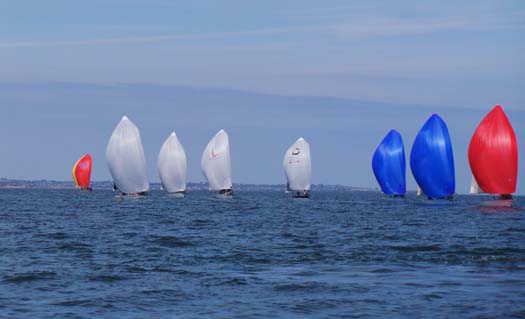
1720s made a welcome return to HYC after over a decade of absence
The 1720 Europeans came down to the wire and was decided in the last race to by the slimmest of margins. After a match race with Denis Murphy’s Aquatack in the last race, Peter O’Leary’s Jacobs Bar emerged victorious by just half a point overall to defend his title from last year. Not far behind the leading pair was a surprise performance from Kenneth Rumball on INSC.ie who rounded out the podium places. Maybe the Dun Laoghaire based team should travel to the events more frequently and the rest of the Dublin based fleet will too. The top performer from outside of Ireland came from Tom Forrestor-Coles and his crew from the south coast of the UK who finished fourth, just two points off the podium.

1720 winners. Pictured Adam Hyland, Cathal Cottrell, Peter O’Leary, Jamie Donegan & Youen Jacob
O’Learys title defence was impressive as earlier this year the boat was in a sorry state after being abandoned for years in a field in Baltimore. Left under a tree with the hatch open the boat was covered in leaves, dirt and the hull was full of water. Before they began the resurrection Cathal Cottrell even joked “We thought of entering the boat in the Chelsea flower show instead of the Europeans when we found her, and we nearly did”. After only rigging a new mast on Thursday night and splashing for the first time early Friday morning, they got off to a relatively slow start but definitely got into their rhythm on Saturday and hauled in Aquatack before conclusion on Sunday. Seventeen year old Adam Hyland was a welcome addition to the crew and O’Leary praised the young talent in his acceptance speech.

Eoin O’Fearghail
When the wind dropped on Saturday for the J24s and J80s racing was as rapid as Elephant Polo. The wind direction chopped and changed to the point where PRO Richard Kissane decided to abandon and restart Race 2. Whereas it didn't suit those doing nicely at the time, it was the sensible decision. The restarted race got away smartly in a bit more breeze allowing the fleet to get all scheduled races under their belts and home in time for tea and tiffin....and after-sun!
Sunday's racing was brought forward an hour to test those who were out the night before. A few cups of Blue Nun did nothing to slow up Flor O'Driscoll and his team who put in a stellar Sunday performance.
Lough Swilly's "Bandit" lived up to its name by putting in a sweet port tack start in Race 5. Open-jawed, the rest of the fleet took some time catching!
Overnight leader Stefan Hyde on Hamilton Bear had a wobbly start to the day but finished off the weekend with a well deserved bullet. In the last they weren’t able to push Hard On Port down the fleet enough in the last to snatch the overall title at the death, so it was second overall for them. Howth Yacht Club’s Under 25 Keelboat Team on Eurocarparks Kilcullen rounded out the podium in third place.
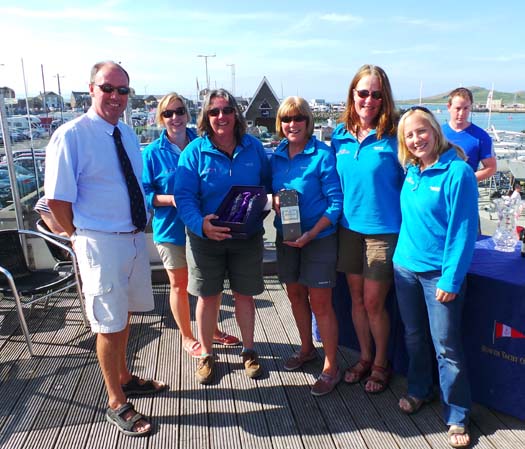
J80 winners. Joan Harris, Gillian Guinness, Elaine Taylor, Sally Watson & Linda Darbey
In the Sailfleet J80 class Gillian Guinness and her ladies team took the title ahead of Mossy Shanahan. In the closely fought class young Ewan McMahon finished a close third. With most of the fleet trading blows Gillian and her crew were very consistent and eked out a lead which meant they had the series wrapped up with a race to spare. There were even sightings of wine and other delights on the sail home each day on board. The bulk of the fleet from second to fifth place were separated by only four points. Exactly what you want and expect from such evenly matched one design racing.
Howth would like to thank all the competitors who made the event as good as it was and Edward Dillon who generously sponsored some prizes. We hope to have everyone back and even more classes involved when we run the event again in 2016.
Full Results here: http://hyc.ie/results
J70 Sportsboat Design Debuts on Dublin Bay Race Track
#J70 – The recent arrival of the 22.75 foot 'pocket rocket' J70 design into the Royal Irish Yacht Club has been creating quite a stir.
The J70 represents the culmination of several years design effort by the highly regarded J boats firm.
Having recently sold his SB20 sportsboat in which Dublin Bay sailor Roger Bannon had enormous fun over the last five years, the new challenge he says is to find an alternative boat which provides a similarly lively and rewarding performance with perhaps a bit more comfort and security.
Is it the J70? He took a spin in one and his conclusions are here on Afloat Boats for Sale site.
Kennedy Seeking SB3 Hat-trick on Lough Ree
Up to 25 boats are expected for the Irish SB3's end of season bash this weekend at the Midland Championships at Lough Ree Yacht Club. This event was first run in 2007 as part of the first SB3 national circuit. The idea was to run a midland event that would rotate between Lough Ree and Lough Derg Yacht Clubs. The event rotates every two years and has been a huge success each year.
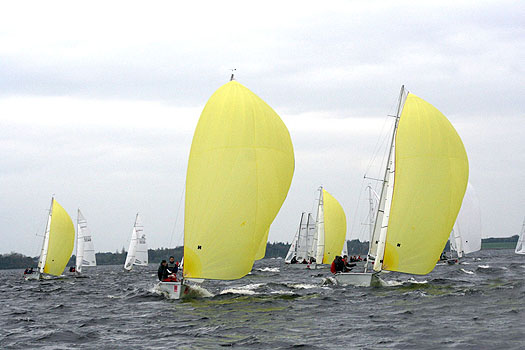
Downwind action in good breeze at the SB3 Midlands on Lough Ree. Photo: Oona Herraghty
Peter Kennedy on Ridgefence will return to defend his title and try to make it a hat trick having won the 2009 and 2010 event on Lough Derg.
The competition is expected to be stiff with Ben Duncan and Brian Moran (Sharkbait) on fire after their National Championships win. Ben also came fourth in last weekend's All Ireland Sailing Championships in Dromineer. A number of the top 10 boats from the Nationals will also be in attendance with Andrew Algeo and Rob Howe both competing.
The event, supported by Galway Maritime, is used to unpredictable weather conditions and over the last few years the fleet has experienced everything from flat calm and blue skies to wet and windy.
1720 European Championships to be Launched on the Lee
The 1720 Sportsboat European Championships and the class national championships will be launched at a "Sailing By The Lee" event on Friday 29th April, 2011 where six 1720's will be raced on the River Lee adjacent to the Headquarters of the Port of Cork. The boats will be brought up river on the Thursday evening and racing will commence at lunch time on the Friday (see below for the Eddie English weather video) which say the class will provide photo and media opportunities at the new marina in the Port of Cork. Each boat will carry sponsorship flags.
In June up to 20 boats go back to their roots when the fleet gathers at Royal Cork Yacht Club for the CH Marine Sponsored National Championships.
A fleet of between 30-35 boats will contest the Corona sponsored Europeans when they set sail off Baltimore in September. There are already confirmed entries travelling from Scotland, Isle of Man, England and Wales while there is also interest coming from Holland where a fleet of eight boats is currently active.
The robust Irish 1720 design has been celebrating a comeback in recent years after cheating death by atrracting a strong following in West Cork, spearheaded by some of the rebel county's top sailors.
The fleet is rapidly becoming the most popular one design keel boat in this part of Ireland. There are now established and growing fleets at Royal Cork, Crosshaven, Kinsale, Baltimore and Schull while Galway Bay also has a growing fleet, racing in Galway Bay. The 2010 Nationals attracted a fleet of over twenty boats,
The series itself will be sailed over a three day period starting on Thursday, 1st September and consisting of nine races in total, three per day. Notice of Race and Entry Forms will be available shortly from Baltimore Sailing Club.
SB3 'Open Day' Concept Goes National
What started out as local recruitment drive on Dublin Bay has widened with interest now reported nationwide for next weekend's Dun Laoghaire SB3 Open Day. Sailors are coming from Howth, Galway and Northern Ireland for test sails at the National YC. "We never imagined there would be so much interest from so many locations out side the Dun Laoghaire area" says class captain Justin Burke.
"Our original intention was to encourage local sailors to try out an SB3 but we will look after everyone. The bookings are coming in at a steady rate and everything thing is in place for a great day. We have racing , boat show , demos and video of the Worlds at Lake Garda", he added.
The Sports Boat concept is focused around close competitive racing on 40 minute courses in easily manoeuvrable one design boats. "You do not need a football team to race just 3 people. And above all they are fast. This is not cheque book racing. Everyone has the same boat same sails so it's all about the racing, Justin says.
Although this concept of racing is not new it is very much in tune with the modern life style where free time is at a premium and the prospect of getting 2 competitive races in 2 hours appeals to helm and crew .
Contact Justin Burke 087 2417542 or drop him a line at [email protected] with your name and number to book a test sail


























